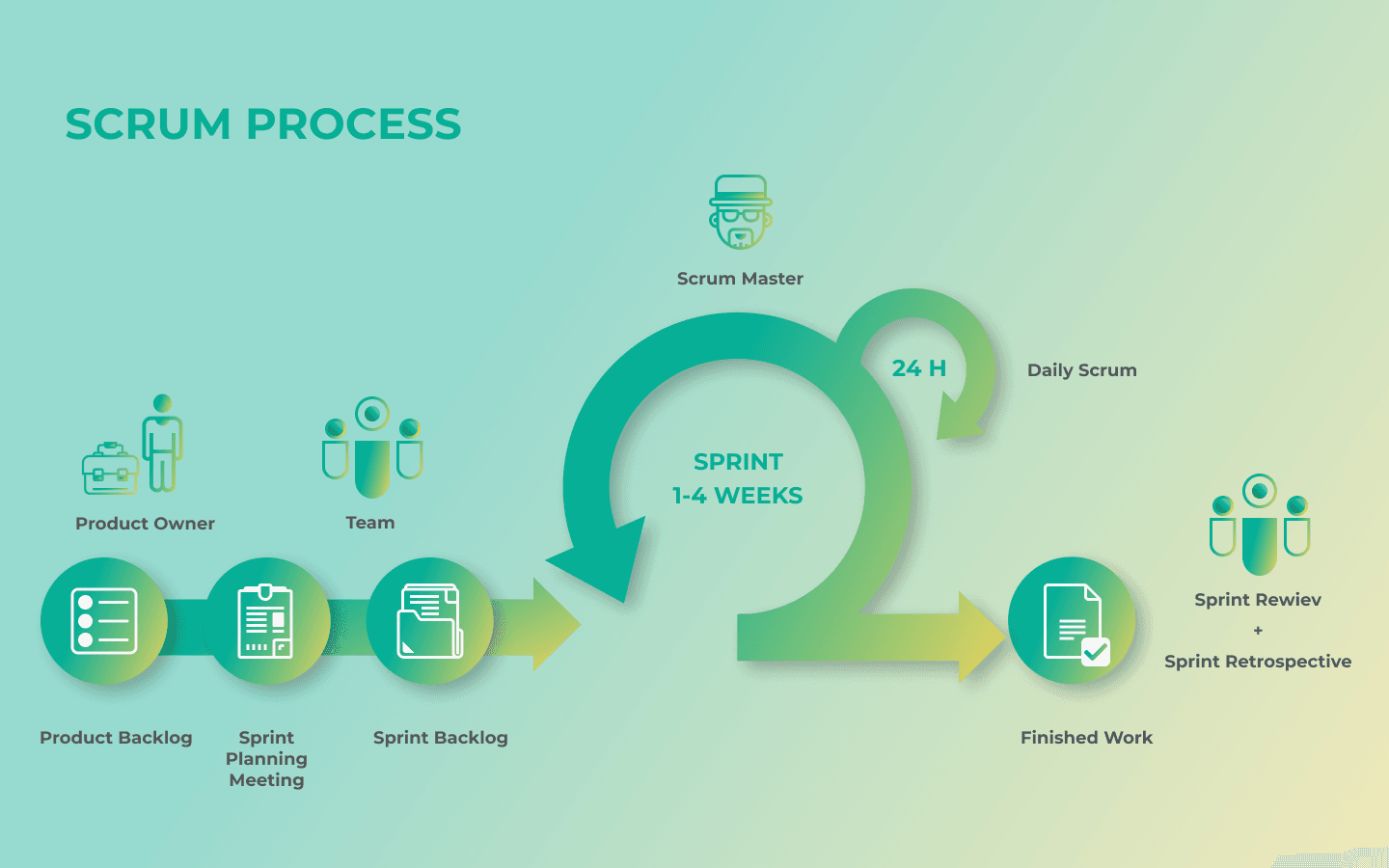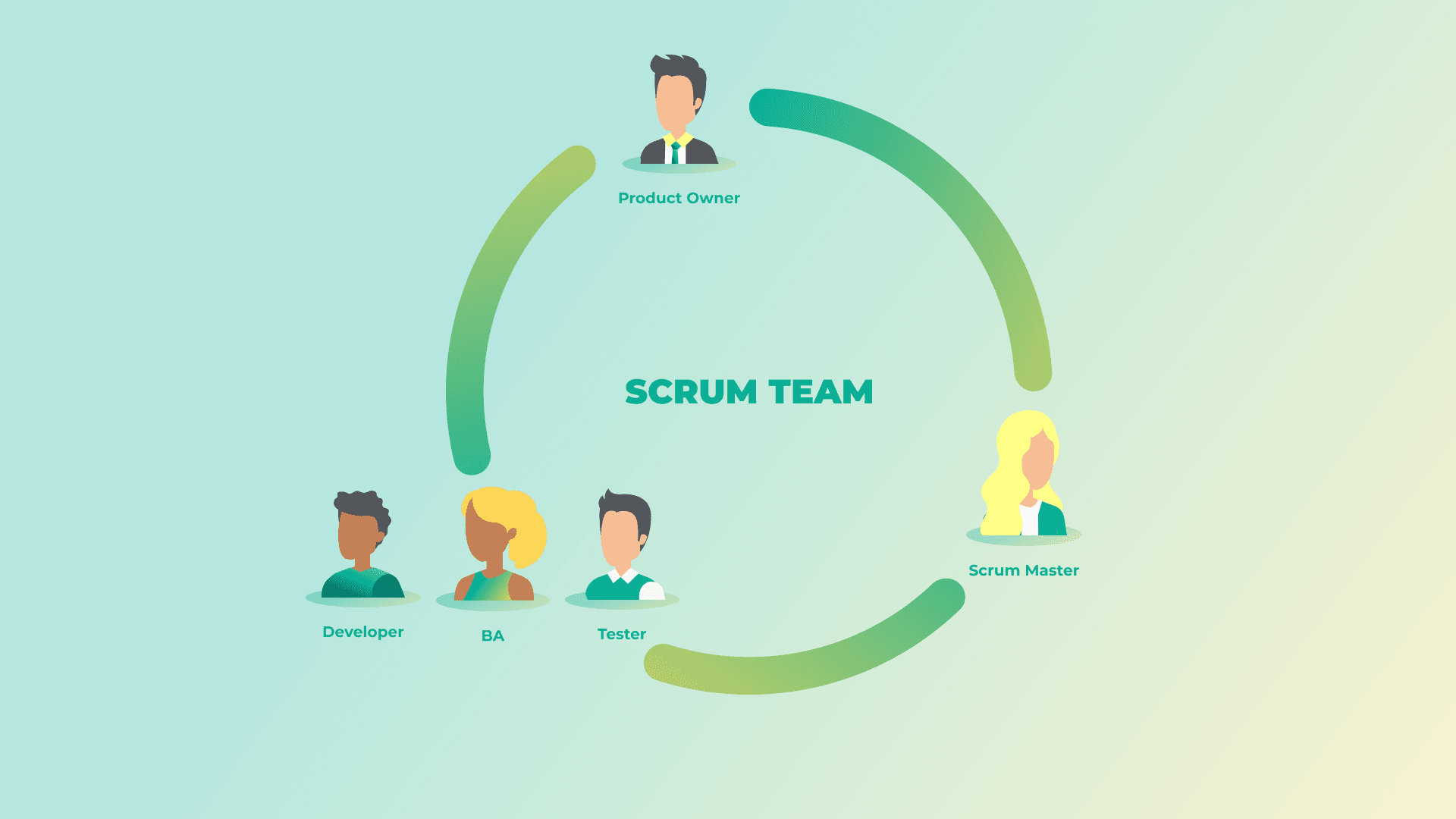How to Write User Stories: Step-by-Step Guide with Examples
Need help writing user stories? Our guide provides examples, a template, and clear steps to create effective user stories for agile projects.
August 11, 2023
Are you tired of traditional project management methods that seem to hinder rather than enhance your team's productivity? Look no further, as the Agile Scrum methodology is here to revolutionise your approach! Agile Scrum is a flexible and collaborative project management framework that promotes effective teamwork, adaptability, and continuous improvement. By breaking down complex projects into smaller, manageable tasks called "sprints," Agile Scrum enables your team to quickly respond to changing requirements and deliver valuable results with utmost efficiency. This methodology fosters open communication, transparency, and a shared understanding of project goals, allowing for faster decision-making and increased productivity.
At the heart of the Agile Scrum methodology lies the Scrum framework. This framework paves the way for a streamlined project management approach, as it segments projects into smaller, more approachable parts termed as sprints. Typically, a sprint extends between one to four weeks, and throughout this period, the team zeroes in on accomplishing a designated set of tasks. As each sprint is initiated, the team puts their heads together to plan the workload, keeping the project's goals and priorities in mind. This methodical step is crucial in organising the software development process.
 Daily Scrum meetings, sometimes known as stand-ups, are held to review progress, tackle any hurdles, and make sure that every team member is on the same wavelength. This is where Scrum values come to the fore, fostering transparency and creating an open environment where issues are addressed promptly.
Daily Scrum meetings, sometimes known as stand-ups, are held to review progress, tackle any hurdles, and make sure that every team member is on the same wavelength. This is where Scrum values come to the fore, fostering transparency and creating an open environment where issues are addressed promptly.
Scrum teams are distinctive in their self-organising and cross-functional nature. This means every team member, with their unique skill set, contributes significantly to the project's success, thereby building a robust Scrum project team. The Scrum Master dons the role of a facilitator, ensuring the team is in line with the Scrum framework and playing a pivotal role in overcoming any obstacles that may arise. This is where the Scrum Master's responsibility is accentuated, helping the team navigate the project management framework effectively.
The Product Owner, another key role in the Scrum framework, is the voice of the stakeholders. They are tasked with prioritising the project backlog, which is essentially a list of tasks waiting to be tackled. This role is especially critical in agile project management as it bridges the gap between the development team and the stakeholders.
The Scrum framework, known as an agile framework, lays down a clear structure for project management, enabling teams to work effectively and adapt to fluctuating requirements. This agility and flexibility are what set Scrum apart from traditional project management methods, marking it as a popular agile framework.
The Agile Scrum methodology operates on several pivotal principles that propel its success and make it a popular Agile framework. One of these founding principles is the acceptance of change. In stark contrast to traditional project management methods, Agile Scrum acknowledges that requirements often shift throughout the development project's lifecycle. This acceptance makes Agile Scrum stand out, as it promotes the Agile approach of welcoming change. Teams using Scrum can respond swiftly and efficiently, making certain that the end product aligns with the stakeholders' changing demands.
A further integral principle is iterative development. The Agile Scrum methodology segments projects into smaller cycles known as sprints. These sprints enable the development team to deliver valuable portions of work at regular intervals, making Agile a continuous iteration process. This iterative approach facilitates early feedback from stakeholders, thereby ensuring the project remains aligned with their expectations. This is where the difference between Agile and Scrum comes to light, as Scrum is a framework that employs the Agile principles in a highly structured manner.
Collaboration and communication form the crux of Agile Scrum. The Agile methodologies prioritise clear and transparent communication among team members and stakeholders. Routine meetings such as the daily Scrum, sprint planning, and sprint review sessions keep team members in sync, allowing them to share progress, tackle challenges, and align their efforts towards the successful completion of the Scrum project.
Agile Scrum methodology significantly varies from traditional project management approaches in several critical aspects. Traditional project management methods, such as the Waterfall model, are linear and sequential. These methods define a clear start and end, with no room for changes or iterations. On the other hand, Agile Scrum is dynamic and adaptable, enabling software development teams to adjust to changes and deliver incremental value throughout the project lifecycle. This is why Agile is often referred to as a philosophy or mindset, rather than just a methodology.
In a traditional project management approach, project requirements are usually outlined at the onset and remain relatively fixed throughout the development process. Any alterations to these initial requirements often entail a substantial amount of work and can impact the project's timeline and budget. In contrast, Agile Scrum sees change as a natural part of the software development process. It encourages stakeholders to provide feedback throughout the project, creating a continuous loop of communication and improvement. This iterative feedback mechanism ensures the end product aligns with the stakeholders' evolving needs and is a primary reason why Agile and Scrum have gained popularity.
Another area where Agile Scrum diverges from traditional project management is in its attitude towards documentation. Traditional methods often necessitate extensive documentation, which can be time-consuming and might not add significant value to the project. Agile Scrum, however, prioritises delivering functioning software over creating comprehensive documents. By focusing on tangible results, Agile practices can streamline the software development process, allowing the project team to concentrate on the most vital aspects of the project and avoid unnecessary paperwork.
Agile Scrum project management is distinguished by its clear definition of roles within the Scrum team, each of which plays a crucial part in the project's success. The three primary roles within Agile Scrum teams include the Scrum Master, the Product Owner, and the Development Team. Let's delve into the specific responsibilities associated with each role:

The Scrum Master ensures adherence to the Scrum framework and principles, making sure that the Agile methodology is correctly implemented in software development projects. Their role involves organising and facilitating Scrum ceremonies such as daily Scrum meetings, sprint planning, and sprint reviews. The Scrum Master’s primary responsibility is to act as a servant-leader for the Scrum team, supporting team members, removing impediments that may hinder progress, and fostering an environment conducive to effective collaboration.
Acting as the voice of the stakeholders, the Product Owner plays a vital role in the Scrum process. Their duties include managing and prioritising the product backlog, clearly defining project requirements, and providing constructive feedback. They work closely with the development team to ensure that the final product aligns with stakeholders' expectations. The Product Owner holds a balancing role, harmonising stakeholder needs with the team's capacity and capabilities.
The Development Team encompasses professionals who execute the project. In Scrum project management, this team is self-organising and cross-functional, implying that each team member possesses a unique skill set that contributes to the project's success. The Scrum team members collaborate in planning and carrying out the work to achieve the project's objectives.
The adoption of Agile Scrum methodology is facilitated by a variety of tools and techniques that can significantly enhance project management efficiency. Let's examine some of the most popular Agile Scrum tools and techniques:
These are either physical or digital boards used to visually track the project's progress. Scrum boards are organised into columns that denote different stages of a task such as "To Do," "In Progress," and "Done." As the development process progresses, team members move tasks across the board, thereby providing a clear, real-time overview of the project status. The use of Scrum boards is a popular Agile practice as it promotes transparency and provides a snapshot of the work done and pending.
These are graphical representations depicting the work left to do versus time. The Agile team uses burndown charts to track their progress toward completing the sprint or the entire Scrum project. By keeping an eye on the remaining work, potential bottlenecks can be identified early, and corrective measures can be implemented to keep the project on track.
Conducted at the end of each sprint, these meetings offer a platform for the entire Scrum team to reflect on their performance during the sprint. This is an opportunity to acknowledge achievements, discuss challenges, and strategise how to improve productivity and collaboration in the upcoming sprints. In Agile software development, these meetings play a critical role in continuous improvement and learning.
User stories are short, simple descriptions of a feature or functionality told from the perspective of the end-user. They help the Scrum team understand the stakeholders' requirements and prioritise tasks based on their business value. User stories serve as a building block for planning and executing tasks in an Agile project.
.
By familiarising yourself with the Scrum framework, accepting its key principles, and applying Agile Scrum tools and techniques, you can greatly enhance the way you manage projects. Tackle obstacles, learn from examples of success, and consider gaining Agile Scrum certification to further improve your skills and expertise. If you're ready to take the leap into the Agile Scrum world and need professional guidance, our team of Agile coaches is just a click away! We offer customised training sessions and workshops to help your team master Agile Scrum. Contact us today to schedule your first session!
Bleiben Sie auf dem Laufenden mit allem, was Sie wissen müssen.
Need help writing user stories? Our guide provides examples, a template, and clear steps to create effective user stories for agile projects.
Learn how to calculate and interpret sprint velocity in Scrum. Find out common challenges and best practices to enhance your team's performance.
Understand the essential goals of sprint planning: objectives, team collaboration, backlog prioritization, and more. A guide for executives.